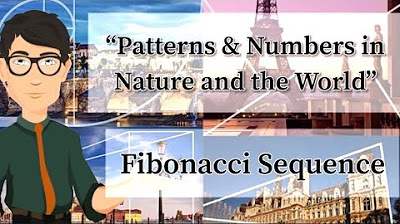PART 2: PATTERNS AND NUMBERS IN NATURE AND THE WORLD || MATHEMATICS IN THE MODERN WORLD
Summary
TLDRThis video explores the fascinating patterns and numbers found in nature, emphasizing the concept of symmetry. It discusses bilateral symmetry using examples like butterflies and Leonardo da Vinci's Vitruvian Man. The video also covers rotational symmetry, illustrated by starfish and snowflakes, explaining the angle of rotation and order of rotation. It delves into the efficiency of hexagonal patterns in honeycomb structures, comparing circular packing with square and hexagonal arrangements to demonstrate the optimal use of space, concluding that hexagons provide a higher percentage of space utilization.
Takeaways
- 😀 Nature exhibits patterns and numbers that suggest a sense of structure and organization, often attributed to intelligent design.
- 🔍 The concept of symmetry is a fundamental pattern in nature, where objects can be mirrored across an imaginary line.
- 🦋 The butterfly is an example of bilateral symmetry, with its left and right sides being mirror images of each other.
- 🧍 Leonardo da Vinci's Vitruvian Man illustrates the proportion and symmetry of the human body.
- 🌟 Starfish demonstrate rotational symmetry, maintaining their appearance when rotated to certain angles.
- 🔄 The angle of rotation for rotational symmetry can be calculated using the formula 360 degrees divided by 'n', where 'n' is the order of rotation.
- ❄ Snowflakes show six-fold symmetry, with their patterns repeating six times, and their angle of rotation being 60 degrees.
- 🐝 Honeycombs are an example of nature's design, with bees using hexagons to optimally utilize space in their honeycomb structure.
- 🔢 The hexagonal formation is more optimal for space utilization due to the honeycomb's efficient packing problem solution.
- 📐 The comparison of square and hexagonal packing shows that hexagons cover a larger percentage of the area, making them more space-efficient.
- 📊 The percentage of space covered by hexagonal packing is approximately 90.69%, compared to 78.54% for square packing.
Q & A
What is the significance of patterns in nature according to the script?
-The script suggests that patterns in nature indicate a sense of structure and organization, which some people interpret as evidence of intelligent design.
What is the definition of symmetry as discussed in the script?
-Symmetry, as discussed in the script, is the property of an object where an imaginary line can be drawn across it, creating mirror images on either side.
Can you provide an example of bilateral symmetry mentioned in the script?
-The butterfly is given as an example of bilateral symmetry, where the left and right portions are exactly the same when divided by an axis.
What is the significance of Leonardo da Vinci's Vitruvian Man in terms of symmetry?
-Leonardo da Vinci's Vitruvian Man illustrates the proportion and symmetry of the human body, showcasing the harmonious balance of its parts.
What is rotational symmetry and how is it demonstrated in the script?
-Rotational symmetry is when a figure can be rotated and still maintain the same appearance. The script demonstrates this with a starfish, which can be rotated and still look the same as its original position.
How is the angle of rotation calculated in the context of rotational symmetry?
-The angle of rotation is calculated using the formula 360 degrees divided by 'n', where 'n' is the order of rotation, indicating the number of times a figure can be rotated to achieve the same appearance.
What is the pattern of a snowflake in terms of symmetry and how is it calculated?
-A snowflake has a six-fold symmetry, meaning the pattern repeats six times. The angle of rotation for this symmetry is 60 degrees, calculated by 360 degrees divided by 6.
Why are hexagonal formations considered optimal in nature, as mentioned in the script?
-Hexagonal formations are considered optimal because they make the most efficient use of space, as demonstrated by the honeycomb structure of bees, which is a solution to the packing problem.
How does the script explain the efficiency of hexagonal packing compared to square packing?
-The script compares the percentage of space occupied by circles packed in a square formation (78.54%) to that in a hexagonal formation (90.69%), showing that hexagonal packing is more space-efficient.
What is the packing problem mentioned in the script and how does it relate to hexagonal formations?
-The packing problem involves finding the optimal method to fill a given space, such as a container. The script relates it to hexagonal formations by explaining that hexagons, like in a honeycomb, provide a more efficient solution to this problem due to their space utilization.
What conclusion does the script draw about hexagonal formations in nature?
-The script concludes that hexagonal formations, as seen in honeycomb structures, are more optimal in making use of available space, highlighting nature's efficiency in design.
Outlines

Этот раздел доступен только подписчикам платных тарифов. Пожалуйста, перейдите на платный тариф для доступа.
Перейти на платный тарифMindmap

Этот раздел доступен только подписчикам платных тарифов. Пожалуйста, перейдите на платный тариф для доступа.
Перейти на платный тарифKeywords

Этот раздел доступен только подписчикам платных тарифов. Пожалуйста, перейдите на платный тариф для доступа.
Перейти на платный тарифHighlights

Этот раздел доступен только подписчикам платных тарифов. Пожалуйста, перейдите на платный тариф для доступа.
Перейти на платный тарифTranscripts

Этот раздел доступен только подписчикам платных тарифов. Пожалуйста, перейдите на платный тариф для доступа.
Перейти на платный тарифПосмотреть больше похожих видео
5.0 / 5 (0 votes)






